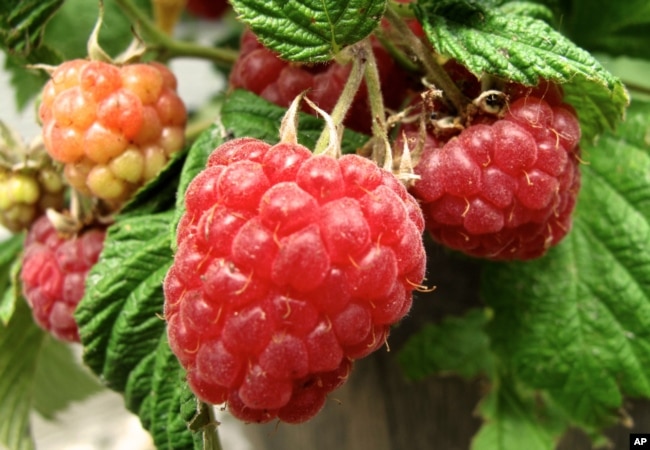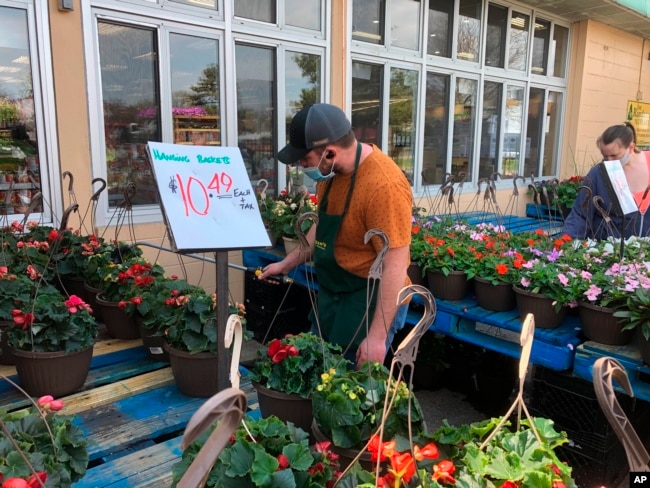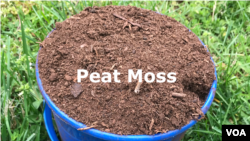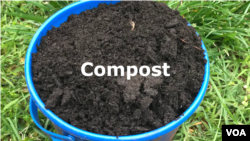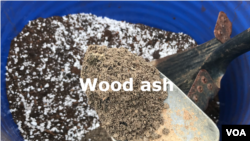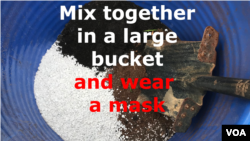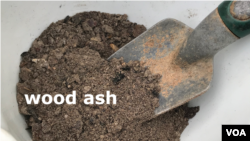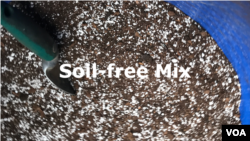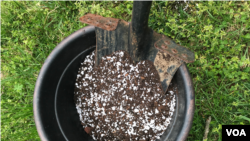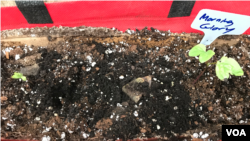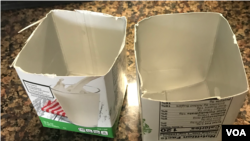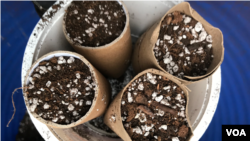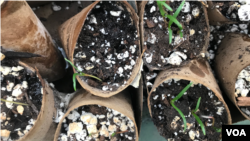ガーデニングはストレス?幸せ?
マンション暮らしの身には
お庭があって・・・イングリッシュガーデンで・・・隅にはハーブ園・・・
季節ごとに花が咲き乱れ・・・ローズのアーチ・・・
お庭でTea Time・・・and so on 妄想は広がり、ガーデン気分。
でも、現実に戻ると 狭いベランダ。
土は? プランターは? 水やりは? 日当たりに風よけは?
そもそも何が植えられる?
そんなあなた、こちらをご覧ください。
目から鱗の素敵な情報を詳細に写真付きで紹介してくれています。
見ているだけで、楽しい!
コンテイナーガーデンで緊張,退屈と戦う(和訳)
フルーツ、野菜その他直物を育てることは人々をより幸せにし、緊張を和らげてくれるとの研究がだされた。泥と植物にまみれることは楽しいに違いない。また、ガーデニングしている時は、屋外で、太陽浴びて、新鮮な空気がいっぱいだ、それにガーデニングは運動にもなる。
とりわけ、庭は家族に健康なフルーツと野菜を提供してくれる。これは私たちの自立心を増してくれるに違いない。甘いトマトや新鮮なさやえんどうにかぶりつくたび、幸せいっぱいに言うのだ。「私が作ったのよ!」ってね。
そうね。でもスペースも、時間も、大きな庭を買うお金もないわ。
じゃ、入れ物でちっちゃなスペースを庭にするってのはいかが。スペースがなくったって、入れものがあればもう庭よ。
もし、入れ物を買うお金がなければ、家の周り近所を眺めまわしてみて。何でだってあなたの庭が始まるわ。バケツ、バスケット、布袋や箱はある?全部使える!
あなたのいる場所を研究しよう
始める前に、場所を決めよう。日がどれくらいさすか?屋上には安全に行けるか?風から守れるか?水やりが簡単に出来るか? これらはすべて重要だ。
正解な植物を選ぼう
あなたの入れ物に対して、土壌、水やりの量は自分で管理できるが、日光はそうはいかない。なので、あなたのいるところの日照条件で育つ植物を見つけよう。
website Gardeners.com では、ほどんどの野菜に必要な日照時間は、少なくとも毎日6時間、もしくは一日中だと言っている。しかし、植物の中には半日蔭でも育つものもある。半日蔭とは、一日の内3時間~6時間、十分な陽光がさすような場所のことだ。
経験則がこれ:もしフルーツや植物の根を食べなら、たっぷりの太陽が必要だ。トマト、ナス、ピーマン、ペポかぼちゃ、ジャガイモ、ニンジン。
もし、葉を食べるなら、半日蔭で育つ。ブロッコリー、カリフラワー、エンドウまめ、豆、ビーツ、ケールにサラダ菜。ハーブも半日蔭でよく育つものがある-例えばミント、コリアンダー、タイム。
入れ物の深さに注意
例えば、ジャガイモ ニンジンはほかの野菜より深めの入れ物が必要だ。普通の入れ物でよく育つ植物の根は深くはない。しかし、あなたのいるエリアでよく育つ植物を探す必要があるだろう。
育てよう!
狭いスペースで忘れてならないのは上に育つということだ。植物のために軽いはしごみたいなものを買ったり作ったりして、よく育つ豆類、キュウリ、トマトを植えよう。
小さなスペースを利用する方法として、つり下げバスケットで下に育てるというのもある。バスケットの深さがあまりないなら、根の浅い植物を選ぼう。イチゴや多くの種類のハーブなんかが小さなつりさげの入れ物でよく育つはずだ。
覚えておいて:これらにはより多くの水やりが必要。
グルーピング
入れ物でするガーデニングでは、同じポットに違う植物を育てられる。省スペースだ。また、組み合わせの良い植物というのもある。
でも、何でもかんでも一緒には植えられない。同じ栄養を奪い合うことになるからだ。それに、また、違う水やり、違う土が必要な物も一緒には植えられない。
風
お住い地域の風に問題があれば、植物を守ることをお忘れなく。風は植物を痛め、乾燥させてしまう。必要に応じ最適な場所を選ぼう。グルーピング植物も一緒にね。
水やり
雨でない限り、毎日同じ時間に水やりをしよう。朝が一番良く、夜の水やりは問題を起こすことがある。でも朝にできないときは、夕方に。日中は水を蒸発させてしますのでNG。葉ではなく、土に直接。葉の水滴は葉にやけどをさせてします。
土と肥料
通常の園芸土はコンテイナーガーデンには向かない。完璧な混ぜ合わせは、ピートモス、バーミキュラーもしくはパーライトそしてコンポスト。発砲スチール、もみ殻もしくは砂は、バーミキュラーもしくはパーライトの代わりになる。
この配合は水、肥料と空気を根まで素早く運んでくれる。水はけもよい。水が底にたまっていると、根腐れを起こす。
すべて準備OK。さあ、始めましょう!
ステップ1. マスクをつけて
ステップ2. 土を作る
ステップ3. 入れ物を選んで
ステップ4. 土を入れ、水やり(布バッグ栽培を紹介)
ステップ5. 種まき、苗植え (仮植えとして卵いれの紙パックやトイレットペーパー の芯利用を紹介)
ステップ6. ラベル貼
ステップ7. 植え替え
(長文につき本文中一部割愛。)
布バッグで出来ちゃうなんて、可愛くって最高ですね。
グルーピング相性も載ってるし、手順も詳しく説明してくれてます。
アイデアいっぱい、いかがでしたか? ガーデニングはストレス? 幸せ?
You never know until you try it!
I'll keep my finger crossed!
私のガーデニング経験-水やり編
長期間留守にするとき、いつも人にお願いするのって気が引けますよね。
それで色々市販の物を買って試してみました。
費用ゼロで、真夏に3週間、植物を一つも枯らすことがなかった方法。
・鉢が収まる入れ物を用意(段ボール箱でも何でもOK)
・大きめのビニール袋(鉢がすっぽり入る大きさ)をその上に掛ける
・鉢を入れる
・たっぷりの水を入れる
・上部を軽くひもで縛っておく
ただただラッキーなだけだったのかも?
ガーデニングに関する英単語豆知識
He is a cutivated person.
cutivate:栽培する
cutivated:教養のある、洗練された
友達との会話で知りました。栽培しか知らなかったので、衝撃。それからは頻繁に使っています。単語って、つい偏ってしまいがち。使ってこそのボキャ。
原文
From VOA Learning English, this is the Health & Lifestyle Report.
Research shows that growing fruits, vegetables and other plants can make us happier and relieve tension. Working with dirt and plants can be fun. Also, when we garden, we are outside, getting sunshine, fresh air and exercise.
Best of all – a garden gives us healthy fruits and vegetables to feed our families. This can increase our sense of independence. Every time we bite into a sweet tomato or a fresh green bean, we can say happily, “I grew this!”
That’s right. But not all of us have space, time or money for a large garden.
Well, you can garden in small spaces with containers. Container gardening is an easy way to grow vegetables when you lack the space. Even on a balcony or rooftop, you can still garden in containers.
If you do not have money to buy containers, look around your home or neighborhood. You can start your garden in just about anything. Do you have buckets, baskets, cloth bags or boxes? You can use all of them!
Research your location.
Before starting, decide on a place. How much sunlight will it get? Do you have safe access to a rooftop? Is it protected from the wind? Are you able to easily water the plants? All these things are important.
Pick the right plants.
In your containers, you can control the soil and the amount of water, but not the sunlight. So, find out which plants can grow in the light conditions you have.
The website Gardeners.com says that most vegetables need at least six hours of sunlight every day or full sun. However, some plants can grow in partial shade. This means direct sunlight for about three to six hours.
Here is a rule of thumb: If you eat the fruit or root of the plant, it needs full sun. This includes tomatoes, eggplant, peppers, squash, potatoes or carrots.
If you eat the leaves, it can grow in partial sun. This includes broccoli, cauliflower, beans, beets, kale and salad greens. Some herbs, such as mint, cilantro and thyme, grow well in partial sun.
Pay attention to the container depth
When growing in containers, the soil depth is important. For example, potatoes and carrots need a deeper container than other vegetables. Plants that do well in containers do not have very deep roots. However, you will have to research which plants grow well in your area of the world.
| Dirt Depth | Plant |
| 10-12 cm (4-5 in) | chives, radishes, lettuce and other salad greens, basil, coriander |
| 15-18 cm (6-7 in) | bush beans, garlic, onions, Asian greens, peas, mint, thyme |
|
20.5-23 cm (8-9 in) |
pole beans, carrots, chard, cucumber, eggplant, fennel, leeks, peppers, spinach, parsley, rosemary |
| 25.5-39.5 cm (10-12 in) | beets, broccoli, okra, potatoes, sweet corn, summer squash, dill, lemongrass |
Grow up!
In small spaces, do not forget about growing upward. You can buy or build a lightweight, ladder-like structure for your plants to grow up. Plants that grow up nicely are peas, beans, cucumbers and tomatoes.
Another way to use a small space is to grow down in hanging baskets. If your baskets are not very deep, pick plants with shallow root systems. Strawberries and many kinds of herbs can grow very nicely in a small hanging container.
Just remember: With smaller containers or hanging baskets, you will need to water them more.
Grouping
With container gardening, you can grow different plants in the same pot. This saves room. And some plants may grow better when paired with another plant.
However, not all plants grow well together. Some compete for the same nutrients. Also, do not grow plants in the same pot if they have very different water and soil needs.
These plants grow well together:
- Beans, carrots and squash
- Eggplant and beans
- Tomatoes, basil and onions
- Lettuce and herbs or
- Spinach, chard and onions
These groupings may not work so well:
- Carrots with dill or fennel
- Tomatoes or squash with potatoes
- Onions or garlic with beans and peas
Wind
If wind is a problem where you live, remember to protect the plants. Wind can damage parts of the plants. It can also dry them out. Choose a location for your garden that has shelter from a building or make your own wind protection. Grouping plants together can help, too.
Water
Your garden will need a regular supply of water. So, try to water your plants at the same time each day unless there is rain. It is best to water early in the morning. Watering at night can cause problems.
However, if you can’t water in the morning, water in the late afternoon or early evening. And put the water directly on the dirt.
Also, try not to water during the hottest part of the day. The water may evaporate too fast. Also, water droplets on leaves can burn them.
Dirt and Fertilizer
Regular garden dirt will not work as well for container gardens. The perfect mix is made up of peat moss, vermiculite or perlite and compost. Styrofoam, rice hulls or sand can be used instead of vermiculite or perlite.
This soil-free mix delivers water, fertilizer and air to plant roots more quickly. It also drains well. If water sits on the roots, you may get root rot.
Also, when growing in containers, plant food, such as compost, is especially important. Some plants just won’t grow without it.
Okay, so you have chosen your location and your plants. Now, you are now ready to start growing!
Here’s how to start your garden.
Make a soil-free mix for container gardening:
Step 1. Wear a mask. The materials are dry. They may irritate your nose and eyes as you mix them.
Step 2. Mix equal parts of peat moss, compost and perlite or vermiculite together with a small amount of wood ash if you have it. If you are using sand, do not use as much because sand is heavy.
|
1. Peat Moss
|
5. Equal amounts of materials
|
|
2. Compost
|
6. Add small amount of wood ash
|
|
3. Perlite
|
7. Wear a mask to mix the dry materials
|
|
4. Wood ash
|
8. Mixed materials
|
Step 3. Choose a container. Anything that will hold the mix and let some water out can be a container garden.
|
1. Place mix in container
|
2. Water it |
You can even use a cloth bag. Use cardboard around the sides and bottom to help it stand up.
Step 4. Fill the container with your mix. Water it well.
|
1. Cloth bag
|
3. Fill with mix |
|
2. Line with cardboard |
4. Plant seedlings
|
Step 5. Start seedlings or buy small plants. To grow from seeds, use any small container, such as egg cartons or milk boxes. You can even use a cardboard toilet paper roll. Simply close one end, put the mix inside, wait for it to grow, then plant it in the ground.
Step 6. Label the plants. You don’t want to forget what you planted! You also can make signs for your garden, reminding you when to water and when to fertilize. You can use your phone to keep notes and reminders. If you like notebooks, like I do, you can keep a record of what you plant.
Step 7. Plant the seedlings. When seedlings have a second set of leaves, you can put them into the larger container. Leave some space between the seedlings so they have room to grow. Water and put in a place that gets some sun.
|
Paper tube
|
Cut a milk box in half
|
|
Fold in one end
|
Both sides can be used
|
|
Fill with mix
|
Milk box seed starter
|
|
Put in seeds
|
Egg carton with mix
|
I hope you have lots of fun with container gardening. I do!
Gardening is fun! And we hope you can grow some tasty and healthy food for your meals.
And join us again next week for another Health & Lifestyle report from VOA Learning English.
